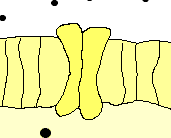The Action Potential
C. George Boeree
In Uzbek: Harakatlar potentsiali, translated by Sherali Niyazova
In Kazakh: Әрекет әлеуеті translated by Alana Kerimova
The movement of a signal through the neuron and its axon is all about ions.
An ion is a charged particle, such as Na+, the sodium ion. It has
a positive charge, because it is missing one electron. Other
ions, of course, are negatively charged.
Cells have membranes that are made of lipid molecules (fats), and they
prevent most things from entering or leaving the cell. But all
over a cell membrane are proteins that stick out on both sides of the
cell membrane. Some of these are ion channels.

ion channel
Most ion channels simply allow ions to flow in or out of the
cell. When we draw diagrams, we usually picture these channels as
if they were little holes in the cell membrane. They are, as I
said, really complex proteins. When an ion attaches itself to one
of these proteins, the protein changes shape, and in doing so carries
the ion to the other side of the membrane, where it is released.
The normal tendency is for everything inside and outside a cell to
balance out this way: If there is too much of a chemical on one side,
it flows to the other, until there's a balance; If there are too many
positive or negative ions on one side, they tend to move to the other
side, until there's a balance.
Some channels are called gates. They can, depending on
their environment, open or close. For some, it's a matter of what
chemicals attach themselves to a part of the gate. For others,
it's a change in the positive-negative balance that causes them to open
or close. In the neuron, there are many such gates, including
sodium gates and potassium gates. Both of these respond to
positive-negative balance changes.


closed............open
One example of a chemical gate
are the receptor sites on the
dendrites of a neuron: When a
chemical called a neurotransmitter attaches itself to a spot on the
gate, the gate opens up to allow sodium ions into the cell.


closed.............open
Other ion channels are called pumps. They use energy
supplied by the cell to actually pump ions in or out of the cell, by
force if you will. The best examples are the sodium-potassium
pumps on the neuron's membranes. These pumps push sodium ions
out of the cell, and potassium ions (K+) into the cell. They are
actually maintaining an imbalance of these chemicals.

ion pump
If you are alert, you notice that both the sodium and the potassium
ions are positive. Neurons actually have a pretty strong negative
charge inside them, in contrast to a positive charge outside.
This is due to other molecules called anions. They are
negatively charged, but are way too big to leave through any
channel. They stay put and give the cell a negative charge inside.
So, when an axon is at rest, the anions give it a negative charge, the
sodium pumps keep sodium out and potassium in, and the sodium gates and
potassium gates are all closed. Because of the positive-negative
difference between the inside and outside, this resting state is called
a resting potential. The word potential refers to the
fact that there is a potential for change here. We use
the same term to refer to a battery that is just sitting there, not
connected to anything: It, too, has a resting potential.
When changes occurring in the membranes of the dendrites and the body
of the cell reach the axon, the sodium gates respond: some of
them open and let sodium ions in, so that the inside starts to become
less negative. If this reaches a certain level, called a threshold,
more sodium gates respond and let more ions in...
Then we have what is called the action potential -- a moving
exchange of ions that runs along the length of the axon. So many
sodium ions get in that, for a very short time, the difference between
the outside and inside of the cell is actually reversed: The inside
is positive and the outside negative.
Then the situation changes: The sodium gates close and the potassium
gates open up. Potassium rushes out of the cell, which brings the
charge inside the cell back down to where it was -- negative on the
inside, positive on the outside.
Notice, though, that the sodium is now inside the cell and the
potassium is
outside, that is, they are in the wrong places. So, the
sodium-potassium pumps
get back to work and pump the sodium back out and the potassium
back in, and things are back to where we started.
Now all this happens at one little segment of the axon at a time:
Sodium goes in at section one; that triggers the potassium to start
going out at section one and the sodium to start coming in at
section two; that in turn triggers the potassium to go out at
section two and the sodium to come in at section three;
and so on -- like a row of dominos going down.
In this little graphic, representing an axon, the red represents sodium
flowing in and the orange represents the potassium flowing out:
The myelin sheath around many axons speeds up this process
considerably: Instead of one tiny segment triggering action at
the very next little segment, the changes "jump" from one gap in the
sheath to the next. This is called saltatory conduction,
from the Latin word for "jump" (also seen in words like somersault).
When the action potential reaches the axon ending, it causes another
ion (calcium, Ca++) to enter the cell, which in turn causes the
vesicles -- the tiny bubbles full of neurotransmitters -- to release
their contents into the synaptic gap....
Amazing, isn't it?
© Copyright 2004, C. George Boeree








